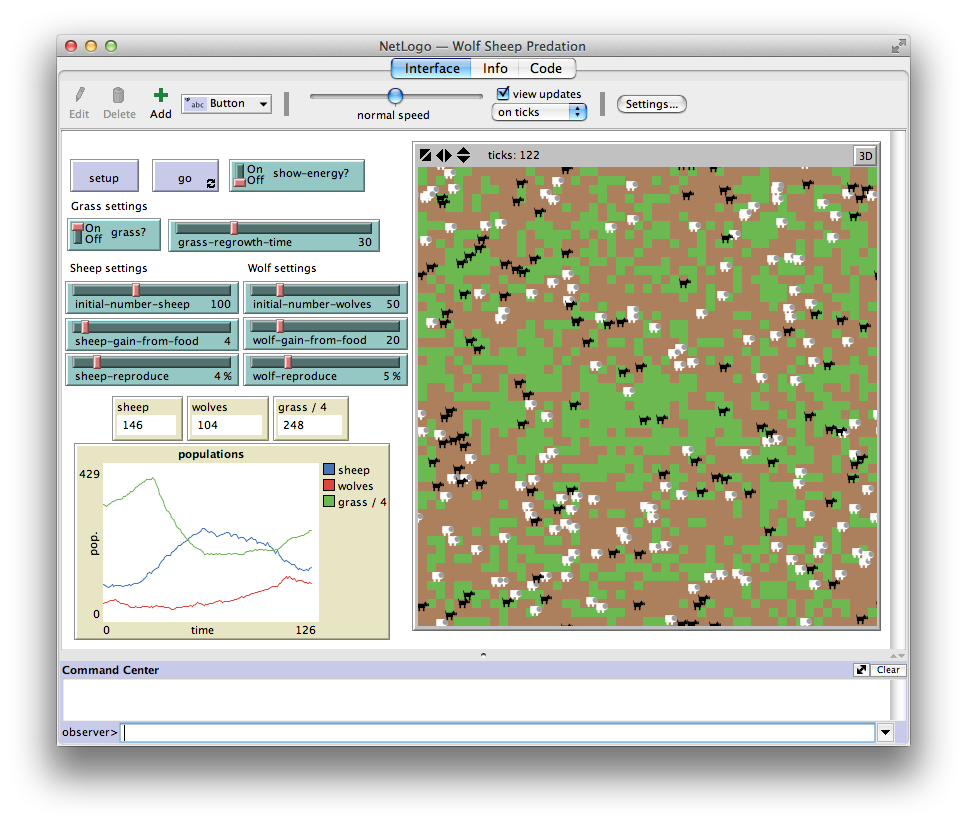Introduction to NetLogo
Overview
Teaching: 5 min
Exercises: 5 minQuestions
What are the different tools used to build ABMs.
Objectives
Increased awareness of the tools used to build ABMs.
NetLogo

Why NetLogo?
- Simple to use
- Great to start creating models
- Community of help (Google is your best friend)
- Cross-platform
- Large Model Library
Let’s go through the wolf and sheep example
- What do the sliders do
- Setup the model and go
- Adjust the speed of the model using the model speed (What are ticks?)
- Use the sliders to set conditions, the number of agents, their behaviour, their interactions, and their external environment.
- Thought experiment: what type of conditions do we want to set (drought conditions, fertile fields… )
- See how they interact and change, but how do we express the output.
- Run model with 3 agents (change model-version to sheep-wolves-grass)
Programming Languages
- NetLogo (based on Scala)
- Python
- Java
- C
- R
What software might help you?
Platform Primary Domain Supporting Organization Operating System GIS Capabilities 3D Capabilities User Support License Programming Language Adaptive Modeler Building agent-based market simulation models for price forecasting of real-world stocks and other securities Altreva; Utrecht, Netherlands Windows Unknown Yes Up to 3 agent properties can be visualized in real-time using 2D graphics and color FAQ, documentation, tutorial, examples, forum, email support Proprietary; free evaluation version available for research and experimentation (some limitations but no expiration) No programming skills required. An adaptive form of genetic programming is used to create trading rules. Users can select functions to be used in the genetic programming engine. AnyLogic Agent-based general purpose; also supports discrete event and system dynamics simulations. The AnyLogic Company; Oakbrook Terrace, Illinois, USA Linux, macOS, Windows Yes: supports both tile maps from free online providers and shapefile-based maps Yes Demos; training; online community; ask a question; online help; tutorials; consulting services Proprietary; Free Personal Learning Edition available Java Cougaar Multi-agent systems; highly distributed, scalable, reliable, survivable applications; Domain independent; large scale distributed, complex, data intensive (can be configured for small-scaled embedded applications) Cougaar Software Inc.; Vienna, Virginia, USA]. Linux, macOS, Windows Yes Integrated with OpenMap No FAQ; tutorials; slide shows; documentation; selected references; email support; public forums; mailing lists Cougaar Open Source License (COSL) is a modified version of the OSI approved BSD License Java Framsticks 2D/3D simulations of (evolving) multi-agent systems and artificial life Poznan University of Technology, Poznan, Poland Cross-platform Yes Yes Email developer; tutorials; manual; FAQ; forums; API; documentation; selected publications; examples Depends on module: GPL/LGPL/Propertiary FramScript (similar to JavaScript) GAMA Platform Modeling and simulation development environment for building spatially explicit agent-based simulations. IRD/SU international research unit UMMISCO, France Windows; Linux; *nix; Mac OS X Yes Yes tutorials; manual; FAQ; forums; documentation; selected publications; examples GPL v3.0 GAML (GAma Modeling Language) for simulations, Java for extensions JADE Distributed applications composed of autonomous entities Telecom Italia; Torino & Parma, Italy Cross-platform Unknown Unknown FAQ; mailing list; defect list; tutorials; API; documentation LGPL version 2 Java MASON General purpose; social complexity, physical modeling, abstract modeling, AI/machine learning George Mason University, Fairfax, Virginia, USA Cross-platform Yes Yes Mailing list; documentation; Tutorials; third party extensions; reference papers; API Academic Free License (open source) Java NetLogo Social and natural sciences; Help beginning users get started authoring models Northwestern University, Evanston, Illinois, USA Cross-platform Yes Yes Documentation; FAQ; selected references; tutorials; third party extensions; defect list; mailing lists GPL NetLogo Repast Social sciences Argonne National Laboratory, University of Chicago; Lemont, Illinois, USA Cross-platform Yes Yes Documentation; mailing list; defect list; reference papers; external tools; tutorials; FAQ; examples BSD Java (RepastS, RepastJ); Python (RepastPy); Visual Basic, .Net, C++, J#, C# (Repast.net) SARL Distributed applications composed of autonomous entities Stéphane Galland, Burgundy Franche-Comté University, France; Nicolas Gaud, Burgundy Franche-Comté University, France, Sebastian Rodriguez, Advanced Informatics Technology Research Group, Tucuman, Argentina Cross-platform Yes By using Java extension libraries, e.g. AFC. Yes By using Java extension libraries, e.g. Java 3D. FAQ; mailing list; bug tracker; tutorials; API; documentation Apache version 2 SARL, Java Soar General purpose AI; human performance modeling; learning (including explanation-based learning) John E. Laird, Clare Bates Congdon, Mazin Assanie, Nate Derbinsky and Joseph Xu; Division of Computer Science and Engineering, University of Michigan, Ann Arbor, Michigan, USA Cross-platform Unknown Unknown Documentation; FAQ; selected publications; defect list; third party extensions; mailing list; contact authors; tutorial; examples; wiki BSD Soar 1 to 5 in Lisp; Soar 6 in C; Java, C++, TCL StarLogo Social and natural sciences; Educators; for students to model the behavior of decentralized systems; user friendly for K–12 students Mitchel Resnick, Eric Klopfer, and others at MIT Media Lab and The MIT Scheller Teacher Education Program, Massachusetts Institute of Technology; Cambridge, MA, USA Cross-platform Unknown Unknown Mailing list; tutorials; FAQ; bug list; documentation; developer contacts Free (closed source) – Clearthought Software License, Version 1.0 StarLogo (an extension of Logo) Swarm General purpose agent based Swarm Development Group Cross-platform Unknown Unknown Wiki; tutorials; examples; documentation; FAQ; selected publications; mailing lists GPL Java; Objective-C This table was shamelessly adapated from Wikipedia - Comparison of Agent Based Modeling Software
References
- Tisue, S., & Wilensky, U. (2004, May). Netlogo: A simple environment for modeling complexity. In International conference on complex systems (Vol. 21, pp. 16-21).
- Thiele, J. C. (2014). R marries NetLogo: introduction to the RNetLogo package. Journal of Statistical Software, 58, 1-41.
- Wilensky, U. (1999). NetLogo (and NetLogo user manual). Center for connected learning and computer-based modeling, Northwestern University. http://ccl.northwestern.edu/netlogo/docs.
Key Points
NetLogo is simple to use, well supported, and a great starting point for agent-based modelling.
NetLogo simulations need to be ‘setup’, then they ‘go’
Ticks can be an arbitrary unit of time.
Plots, graphs, and numbers can be used to output the results of your model.
Can run multiple simulations using the NetLogo BehaviourSpace feature.